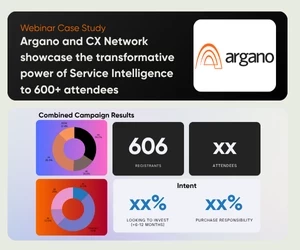Contact the customer directly and your NPS scores will soar
Add bookmark
The Chief Customer Officer of Sure International says that customer satisfaction is a company-wide responsibility and every team member has to be on board.
Charlotte Dunsterville is the Chief Customer Officer of Sure International, responsible for revenue performance, consumer sales, customer experience and operational performance.
Prior to her role at Sure International, Dunsterville applied her customer experience and commercial skills at Batelco as the Head of Customer Experience. Before joining Batelco, she enjoyed 11 years at Orange in a wide range of customer experience roles, serving as the Head of Customer Experience Strategy, Director of Customer Base Marketing, and the Director of Customer Experience where she promoted 1-1 customer marketing and emotional engagement.
In this interview, Dunsterville sat down with the Editor of CX Network, Zarina de Ruiter, to discuss the most effective ways of gauging customer and employee feedback. In addition, she also discusses the customer journey and making sure customers feel like their feedback is being listened to.
Zarina de Ruiter (ZDR): Welcome to CX Network today. First of all, in the age of survey fatigue, what are the ways you capture customer feedback in a less time-consuming and less intrusive way?
Charlotte Dunsterville (CD): We’re still using surveys quite a lot and we use them in different ways. What we are trying to do is keep the surveys as short as possible and make sure all the questions are really relevant. We’ll ask the NPS question and then we follow up with why has the customer given us that score, but we try not to go into multiple questions and taking them down a road.
SEE ALSO:10 inspiring podcasts to level up your customer experience on-the-go
“What we are trying to do is keep the surveys as short as possible and make sure all the questions are really relevant.”
We’re trying to keep the surveys short but we do still survey. We use three methods to get customer feedback.
1. We use our NPS programme, which is both transactional at the touchpoints and it’s relational, so we do a brand NPS survey four times a year.
2. We have a customer panel which we don’t just use for surveys and feedback, but we’ll take things like new products to them and ask what they think and how we should design it. We’re talking to them about our new self-serve platform, for example. We get lots of useful feedback from our customer panel, and they’re very engaged, which is good.
3. The other thing that we have is employee feedback. We ask employees how they think we deal with customers and alongside that we also ask them a range of questions about working at Sure. How they find it, what they would improve in lots of different areas, their relationships with managers, whether they feel well rewarded and well recognised, etc.
ZDR: How do you capture feedback for your employees?
CD: We use surveying. We find that it’s the most effective and we use an automated platform, meaning that every employee gets a question of the week. They answer the question and then it follows up with more questions, including a free text field. They’re free to tell us whatever they’re thinking about, whether it’s the new chairs in the canteen, the way we deal with customers or something else.
SEE ALSO: Nissan drives trust, transparency and proactivity for CX excellence
ZDR: What do you do with the information you capture from employees and how can they really see changes?
CD: We have a weekly cross-functional meeting with the marketing team and product team, and people from all across the business. We’ll present any points of feedback, particularly from our quarterly survey, and we discuss the positive, which tend to be about our customer services which is really strong, particularly in the retail shops and at the contact centre. And then we discuss anything which has come across more negative.
“We have a weekly cross-functional meeting with the marketing team and product team, and people from all across the business. We’ll present any points of feedback.”
A good example of that would be in the middle of last year. We had some feedback about our mobile data usage, where customers felt their allowance was being used up very quickly and they weren’t very clear about how much they had. As a result of that, and talking about it at a meeting, we made sure that the way we were explaining the mobile data was much better. We also launched plans which gave customers much better value for their allowance.
It’s not just going back to the customer-facing people, although we do that, it’s also being discussed all across the business and we take action together.
ZDR: Can you give an example of how you made customer feedback actually work towards the customers and how they have reacted?
CD: If we get some particularly good feedback, it would go back to the staff who had served that customer. If we get feedback which is more negative, we take that to the manager of that team. It could be feedback about the bill, about the product or it could be about the way that the customer has been served. And then we ask the manager of that team to look into it, to make sure it’s not coming back to the Complaints Manager, but being shared across the business. And then action is taken in the right team.
“If we get some particularly good feedback, it would go back to the staff who had served that customer.”
ZDR: Do you communicate it back to the customer if it’s a case where they would necessarily notice if a change has been made?
CD: Yes. The manager of that team will get back to the customer and have a conversation. For example, if it was a network problem, you might find that the Network Manager is contacting that customer directly.
ZDR: The lines between all of these different channels are increasingly blurred. How do you interlink the different touchpoints to really paint one consistent voice of the customer?
CD: We’re quite a small organisation, making us quite agile which is really positive for us. Almost all of the customer touchpoints come within my team. We work on them together as a joint team and having a joint purpose of wanting to improve.
Additionally, because there’s not too many of us we don’t have to do a lot of stakeholder management or juggle work with big teams. Because we manage it all together in a small team, it gives us a common sense of purpose.
“Almost all of the customer touchpoints come within my team. We work on them together as a joint team and having a joint purpose of wanting to improve.”
ZDR: How does all of this feedback into a successful long-term loyalty and retention strategy? And how do you create real customer satisfaction?
CD: First of all, it’s being discussed all across the business. It’s not a specific team which has responsibility and everybody else says, “Oh, that’s not my job, it’s yours”. I think the main thing for me is that it’s recognised throughout the business that we want to give a fantastic customer experience and we’re all involved in that. That’s the main thing.
Furthermore, we do get back to customers so they feel listened to and they know that we value their opinion. Those two things really, managing it across the whole business and then making sure customers know that we’ve listened to them and we’re taking action.
ZDR: What metrics do you use to measure that customer satisfaction?
CD: Our key metric is NPS. We also use CSAT, and a customer ethics score as well. We try to have a balanced set of metrics, but primarily we use NPS.
“I think the main thing for me is that it’s recognised throughout the business that we want to give a fantastic customer experience and we’re all involved in that.”
ZDR: Do you combine them all do you look at the different elements of the customer feedback strategy in silos?
CD: We have different NPS targets and reports, and that all combines into a company-wide NPS.
ZDR: Has there been anything you’ve done where you saw a really large spike in NPS or any of the other scores, where it really improved dramatically?
CD: When we started getting managers to take responsibility for feedback in their area, and go back to customers directly, we had some really good responses to that.
ZDR: It’s all about communications. The customer wants to know that they’re valued and change is being made.
CD: Exactly. We know this from the customer panel as well. We know that our customers are really engaged because they feel listened to. We go back to them and tell them what we’re doing as a result of their feedback. I think that’s also really positive.
SEE ALSO: The positive economics of customer engagement
Want to hear more from Charlotte? Check back in two weeks time for the second part of this interview in which Charlotte is asked three further questions. The topics discussed; the best customer experience she has received, personalisation and its place in larger businesses and the foremost customer experience insights going into 2018.
Can’t get enough of our podcasts?
Join Angela Hunter, the Chief Customer, Marketing & Digital officer at Prudential, as she sat down with CX Network to discuss the importance of being customer centric. Angela shared insights about the implementation of new measurement systems, understanding segmentation and lifecycle management and more. Check out the podcast below!

























